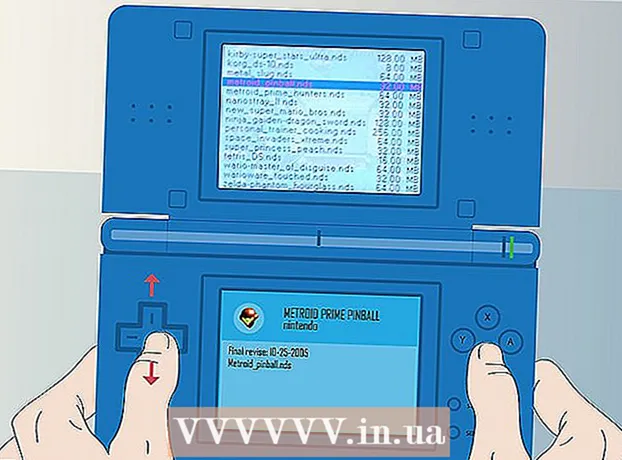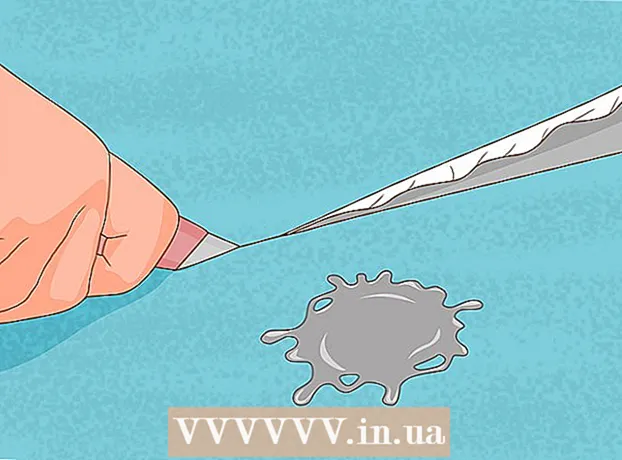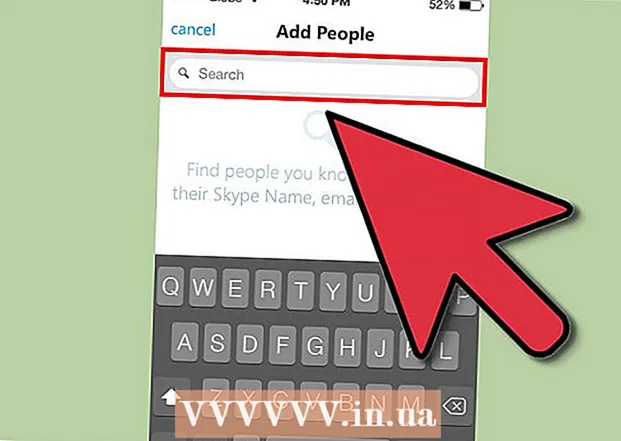
Content
- Steps
- Method 1 of 3: Extinguishing Electrical Fires
- Method 2 of 3: Extinguishing Liquid Fuels and Oils
- Method 3 of 3: Suppressing Organic Solid Ignitions
- Tips
- Warnings
- What do you need
When a fire just flares up, the flame can be so small that it can be safely extinguished with a fire blanket or fire extinguisher at hand. With prior preparation and the ability to quickly identify the type of fire you are dealing with, you will not only increase your chances of successfully extinguishing the fire, but also your chances of getting the job done without risking your health. However, do not forget that the safety of others in the immediate vicinity of the fire (including you) is paramount. If the fire spreads quickly, the combustion is accompanied by abundant smoke emission, or the flame cannot be extinguished with a fire extinguisher in five seconds, you need to turn on the fire alarm, evacuate the building and call the firefighters by phone 101.
Steps
Method 1 of 3: Extinguishing Electrical Fires
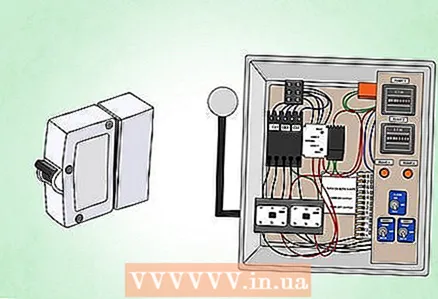 1 Prevent the fire before it starts. Most electrical fires are caused by damaged wires and poor electrical maintenance. To prevent a fire beforehand, do not overload electrical outlets with operating equipment, and have any electrical work performed by a professional electrician.
1 Prevent the fire before it starts. Most electrical fires are caused by damaged wires and poor electrical maintenance. To prevent a fire beforehand, do not overload electrical outlets with operating equipment, and have any electrical work performed by a professional electrician. - Keep electrical systems protected from dust, debris, and cobwebs that could cause a fire.
- Wherever possible, use circuit breakers and fuses in the building wiring.This is a fairly simple step in order to be able to de-energize the premises in the event of a starting fire.
 2 Turn off the electricity completely. If sparks occur in the electrical network, wires, equipment or sockets are ignited, then the first and best step is to completely turn off the electricity. If only sparks have appeared in the electrical network, but no fire has occurred, this step should be enough to prevent a fire.
2 Turn off the electricity completely. If sparks occur in the electrical network, wires, equipment or sockets are ignited, then the first and best step is to completely turn off the electricity. If only sparks have appeared in the electrical network, but no fire has occurred, this step should be enough to prevent a fire. - The electricity supply must be turned off at the electrical panel, and not at the switch of the problem outlet.
- If the problem is with damaged wires or electrical equipment, do not simply unplug the plug. Electrical problems very often lead to electric shock to people.
 3 If you cannot turn off the electricity, use a class E fire extinguisher (for extinguishing live electrical installations). The type of fire extinguisher that can be used in a given situation depends entirely on whether you have the option to turn off the electricity or not. If you do not know where the electrical panel is, it is locked or it takes too long to get to it, then you should use a class E fire extinguisher.It will be either a carbon dioxide fire extinguisher (with carbon dioxide CO2) or a dry powder fire extinguisher, and class E will be indicated on the label of the fire extinguisher cylinder. in the list of fire classes for which it is suitable.
3 If you cannot turn off the electricity, use a class E fire extinguisher (for extinguishing live electrical installations). The type of fire extinguisher that can be used in a given situation depends entirely on whether you have the option to turn off the electricity or not. If you do not know where the electrical panel is, it is locked or it takes too long to get to it, then you should use a class E fire extinguisher.It will be either a carbon dioxide fire extinguisher (with carbon dioxide CO2) or a dry powder fire extinguisher, and class E will be indicated on the label of the fire extinguisher cylinder. in the list of fire classes for which it is suitable. - To use a fire extinguisher, break the seal, pull out the pin that prevents the lever from being pressed, point the fire extinguisher nozzle at the base of the fire and press the lever. Seeing that the flame retreats, come closer to the fire, continuing to extinguish it with a fire extinguisher until the fire completely disappears.
- If you are unable to extinguish the flame with a fire extinguisher in five seconds, the fire is too strong. Evacuate to safety and call 101 firefighters.
- Since the defective equipment is still energized, the fire can reignite. Therefore, you need to turn off the electricity as soon as possible.
- You should only use a Class E powder or carbon dioxide fire extinguisher as its contents are not conductive. A Class A water extinguisher will contain pressurized water which is a good conductor and creates the risk of electric shock.
- Sometimes (but not always) water fire extinguishers can be distinguished from carbon dioxide and powder fire extinguishers by their color (they may not be red, but silver). Also, carbon dioxide fire extinguishers usually have a large nozzle, instead of a simple hose of water extinguishers, which also have a pressure gauge.
 4 If you turn off the electricity, use a class A fire extinguisher or dry powder fire extinguisher. If you manage to completely shut off the power supply to the ignition source, then you have turned a class E fire into a class A fire.In this case, you will be able to use a class A water extinguisher in addition to the previously mentioned class E fire extinguishers.
4 If you turn off the electricity, use a class A fire extinguisher or dry powder fire extinguisher. If you manage to completely shut off the power supply to the ignition source, then you have turned a class E fire into a class A fire.In this case, you will be able to use a class A water extinguisher in addition to the previously mentioned class E fire extinguishers. - In such a situation, it is recommended to use class A water extinguishers and universal dry powder extinguishers, as carbon dioxide extinguishers pose a greater risk of smoldering, and the fire can reignite when the carbon dioxide dissipates. Also, carbon dioxide fire extinguishers can cause respiratory problems if used in confined spaces such as at home or in small offices.
 5 Use a fire blanket to extinguish the flames. Alternatively, you can use a fire blanket to extinguish the fire, but this is only permissible if you have been able to completely shut off the power to the ignition source.Despite the fact that fire blankets are most often made from wool felt (chemically treated), which is a good dielectric, there is no need to take risks and get close to the fire source, unless the power supply is turned off and there is a risk of electric shock.
5 Use a fire blanket to extinguish the flames. Alternatively, you can use a fire blanket to extinguish the fire, but this is only permissible if you have been able to completely shut off the power to the ignition source.Despite the fact that fire blankets are most often made from wool felt (chemically treated), which is a good dielectric, there is no need to take risks and get close to the fire source, unless the power supply is turned off and there is a risk of electric shock. - To use a fire blanket, remove it from the packaging, unfold it and hold it in front of you to protect your hands and body, then cover a small fire with it. DO NOT THROW the coverlet over the fire.
- This will not only be a very effective step in the early stages of a fire, but it will also avoid damage to the surrounding area and objects.
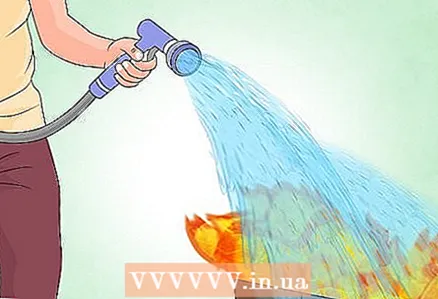 6 Put out the fire with water. If you don't have any fire extinguishers or fire blankets on hand, you can use water. However, use water ONLY IF you are 100% sure to turn OFF the POWER SUPPLY completely. Otherwise, you risk not only getting an electric shock, but also causing a rapid spread of fire due to electrical discharges. Water should be poured into the base of the flame (ignition source).
6 Put out the fire with water. If you don't have any fire extinguishers or fire blankets on hand, you can use water. However, use water ONLY IF you are 100% sure to turn OFF the POWER SUPPLY completely. Otherwise, you risk not only getting an electric shock, but also causing a rapid spread of fire due to electrical discharges. Water should be poured into the base of the flame (ignition source). - The amount of water that can be obtained from the faucet will only be effective in extinguishing small fires in a confined space. Otherwise, the fire will have time to spread before you fill it.
 7 Call the fire department on 101. Even if you have extinguished a fire, it is wise to call the firefighters by calling 101. Smoldering objects can re-ignite, and professional firefighters will help to completely isolate the fire and completely eliminate the risk of re-fire.
7 Call the fire department on 101. Even if you have extinguished a fire, it is wise to call the firefighters by calling 101. Smoldering objects can re-ignite, and professional firefighters will help to completely isolate the fire and completely eliminate the risk of re-fire.
Method 2 of 3: Extinguishing Liquid Fuels and Oils
 1 Shut off the fuel supply. When igniting flammable liquids, the first step is to shut off the flow (where applicable). For example, if gasoline ignites on a gas station dispenser from a spark of static electricity, you must first activate the dispenser's emergency switch, which should be located next to each dispenser. This action will cut off small fires from large fuel tanks.
1 Shut off the fuel supply. When igniting flammable liquids, the first step is to shut off the flow (where applicable). For example, if gasoline ignites on a gas station dispenser from a spark of static electricity, you must first activate the dispenser's emergency switch, which should be located next to each dispenser. This action will cut off small fires from large fuel tanks. - In many cases, when the flammable liquid is the only substance feeding the fire, it can be extinguished immediately after the supply of the substance has been shut off.
 2 Use a fire blanket to put out the fire. A fire blanket can also be used to extinguish small Class B fires. If a blanket is at hand, it is easiest to put out a fire blanket with minimal damage.
2 Use a fire blanket to put out the fire. A fire blanket can also be used to extinguish small Class B fires. If a blanket is at hand, it is easiest to put out a fire blanket with minimal damage. - To use a fire blanket, remove it from the packaging, unfold it and hold it in front of you to protect your hands and body, then cover it with a small flame. DO NOT THROW the coverlet into the fire.
- Make sure the fire is not too extensive to be extinguished with a blanket. For example, igniting vegetable oil in a frying pan would be a small enough fire source to apply a fire blanket.
 3 Use a class B fire extinguisher. As with electrical fires, Class A water extinguishers cannot be used to extinguish liquid fuels and oils. Whereas carbon dioxide (CO2) and dry powder fire extinguishers can be used in class B fires (with the ignition of liquid substances). Check the information on the extinguisher cylinder and make sure it is suitable for class B fires before extinguishing a flammable liquid fire.
3 Use a class B fire extinguisher. As with electrical fires, Class A water extinguishers cannot be used to extinguish liquid fuels and oils. Whereas carbon dioxide (CO2) and dry powder fire extinguishers can be used in class B fires (with the ignition of liquid substances). Check the information on the extinguisher cylinder and make sure it is suitable for class B fires before extinguishing a flammable liquid fire. - To use a fire extinguisher, break the seal, pull out the pin that prevents the lever from being pressed, point the fire extinguisher nozzle at the base of the fire and push the lever. Seeing that the flame is extinguishing, move closer to the fire and continue to extinguish it until the very end.
- If you cannot extinguish the flame with a fire extinguisher in five seconds, then it is too strong. Evacuate to safety and call 101 firefighters.
- It should be noted that the main causes of fires in bars, restaurants and cafes are most often violations of the rules for operating kitchen equipment. It is for this reason that the kitchens of catering establishments are necessarily equipped with fire extinguishers (usually carbon dioxide). Their number is determined based on the area of the serviced premises. Also, these enterprises should have other fire equipment: boxes with sand, fire blankets and buckets, a fire hook, an ax, a crowbar and a fire hose with a working crane.
- DO NOT flood flammable liquids or oils with water. Water does not mix with oil. When these two substances come into contact, the oil remains on the surface of the water. At the same time, the water very fast boils and turns into steam. And since it is under the burning oil, the oil begins to scatter in all directions along with boiling and evaporating water. This leads to a rapid spread of fire.
 4 Call the fire department on 101. Even if the fire is extinguished, you should call the fire department by calling 101. Smoldering objects can re-ignite, and professional firefighters will help to completely isolate the fire and completely eliminate the risk of re-fire.
4 Call the fire department on 101. Even if the fire is extinguished, you should call the fire department by calling 101. Smoldering objects can re-ignite, and professional firefighters will help to completely isolate the fire and completely eliminate the risk of re-fire.
Method 3 of 3: Suppressing Organic Solid Ignitions
 1 Use a fire blanket to put out the fire. If the fire source is solid combustible materials (wood, fabric, paper, rubber, plastic, etc.), then the fire belongs to class A. A fire blanket will allow you to quickly and easily extinguish the initial stage of a class A fire. It will block the access of oxygen to the fire site. which fuels the combustion process.
1 Use a fire blanket to put out the fire. If the fire source is solid combustible materials (wood, fabric, paper, rubber, plastic, etc.), then the fire belongs to class A. A fire blanket will allow you to quickly and easily extinguish the initial stage of a class A fire. It will block the access of oxygen to the fire site. which fuels the combustion process. - To use a fire blanket, remove it from the packaging, unfold it and hold it in front of you to protect your hands and body, then cover it with a small flame. DO NOT THROW the coverlet over the fire.
 2 Use a Class A fire extinguisher to put out the fire. If you do not have a fire blanket handy, you can use a fire extinguisher to extinguish a Class A fire. Make sure the class A fire extinguisher cylinder is listed.
2 Use a Class A fire extinguisher to put out the fire. If you do not have a fire blanket handy, you can use a fire extinguisher to extinguish a Class A fire. Make sure the class A fire extinguisher cylinder is listed. - To use a fire extinguisher, direct a stream of substance from the nozzle of the fire extinguisher to the base of the fire and stir the stream back and forth until the fire is extinguished.
- If you cannot extinguish the flame with a fire extinguisher in five seconds, then it is too strong. Evacuate to safety and call 101 firefighters.
- Fire extinguishers, which are only intended to extinguish Class A fires, contain pressurized water and are equipped with a pressure gauge. However, many versatile dry powder extinguishers can also be used for Class A fires.
- Use a carbon dioxide (CO2) extinguisher for Class A fires only if it is the only type of extinguisher you have (but is not recommended). Class A facilities tend to smolder for a long time, and fires can easily re-start once the CO2 has cleared.
 3 Use plenty of water. Since Class A fire extinguishers contain pressurized water, you also have the option of using plenty of regular tap water if that's all you have on hand. But if a fire spreads faster than you can extinguish it, or too much smoke is emitted from the fire, threatening your safety, you should evacuate to a safe place and call the fire department by phone 101.
3 Use plenty of water. Since Class A fire extinguishers contain pressurized water, you also have the option of using plenty of regular tap water if that's all you have on hand. But if a fire spreads faster than you can extinguish it, or too much smoke is emitted from the fire, threatening your safety, you should evacuate to a safe place and call the fire department by phone 101. 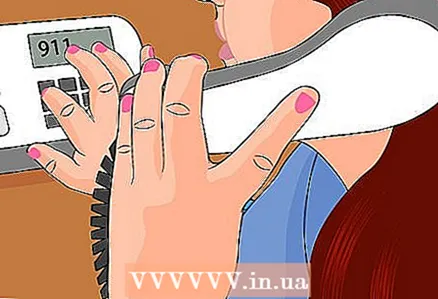 4 Call the fire department on 101. As with any fire, you need to call the fire department on 101, even if you managed to put out the fire. Firefighters will check that the fire has no chance of flaring up again.
4 Call the fire department on 101. As with any fire, you need to call the fire department on 101, even if you managed to put out the fire. Firefighters will check that the fire has no chance of flaring up again.
Tips
- If you use a fire blanket, do not remove it from the fire for at least 15 minutes or until the heat has completely disappeared.
- Check out the different types of fire extinguishers in your home and office.The faster you get to the right fire extinguisher, the more chances you have to extinguish the fire at the initial stage.
- Get to know the location of the electrical panel in your home and office. In the event of an electric fire, you should get to the electrical panel as soon as possible to turn off the electricity.
- Even if you have successfully extinguished the fire, it is best to call the firefighters (101) so that they can make sure that the fire does not reignite.
- If you've cooked in a skillet with oil and the oil ignites, use baking soda to put out the flames.
Warnings
- If you suspect a gas leak, evacuate the premises or shut off the gas supply (if safe to do so) and immediately call the emergency gas service (104) or the general rescue service (112). In the event of a gas leak, do not use a cellular or cordless telephone (but only a landline wired one)! Also, do not turn on or off any electrical appliance. Ventilate the area by opening all windows and doors (if safe to do so). However, if a gas leak occurs outside the building, the windows and doors should be closed on the contrary. Natural gas is extremely flammable and can quickly fill up indoor spaces. In the event of a spark, the ignition will be explosive and the ensuing widespread fire cannot be extinguished without the assistance of professional firefighters.
- This article provides general guidelines on how to try to extinguish a very small fire during the initial stage of ignition. Use this information at your own risk and use extreme caution in the event of fire.
- Breathing in smoke is also very dangerous. If the fire progresses to a stage where a lot of smoke is emitted, evacuate and call the firefighters (101).
- If you cannot extinguish the flame with a fire extinguisher within five seconds, then it is too strong. The fire extinguisher charge will most likely run out faster than you can extinguish the fire. Evacuate to a safe place and call the firefighters (101).
- Your life comes first. Evacuate if the fire begins to spread and becomes unlikely to be extinguished by conventional means. Don't waste time saving personal items. Speed is important here.
What do you need
- Water (only in case of class A fire)
- Fire blanket
- Fresh fire extinguisher with clearly visible instructions on it
